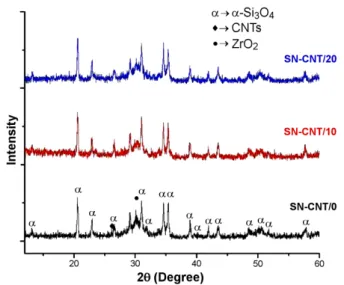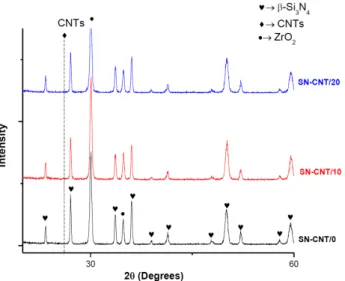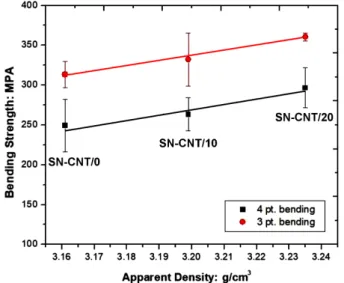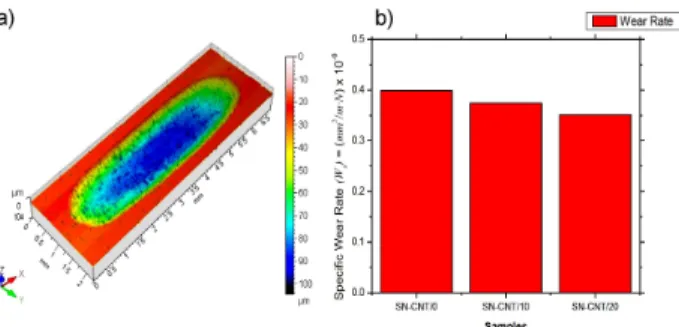Properties of MWCNTs added Si
3N
4composites processed from oxidized silicon nitride powders
Awais Qadir
1, Katalin Balazsi
2, Csaba Balazsi
2, Michal Ivor
3, Jan Dusza
1,3,∗1Doctoral School of Materials Sciences and Technologies, Óbuda University, Bécsi ut. 96/b, 1034 Budapest, Hungary
2Institute of Technical Physics and Materials Science, Centre for Energy Research, 1121 Budapest, Konkoly-Thege str 29-33, Hungary
3Institute of Materials Research, Slovak Academy of Sciences, Watsonova 47, 04001 Košice, Slovak Republic Received 13 September 2019; Received in revised form 1 December 2019; Accepted 24 January 2020
Abstract
Si3N4/3 wt.% multi-walled carbon nanotubes (MWCNTs) composites were prepared from oxidized α-Si3N4
powders and sintering additives by hot isostatic pressing (HIP). The Si3N4powders were oxidized at 1000 °C in ambient air environment for 10 and 20 h and the powder mixture was sintered at 1700 °C for 3 h under the pressure of 20 MPa in nitrogen. The relationship between oxidation, microstructure, tribology and mechanical properties was studied. The dispersion of MWCNTs was not optimal, as they were found mainly in the form of bundles between theβ-Si3N4grains. Neither Si2N2O nor other oxide phase were observed after the sintering.
This was probably caused by the presence of MWCNTs at the grain boundaries of the Si3N4 grains causing reduction of oxide phases. The density, hardness, bending strengths and friction coefficient of the composites increased with the oxidation time of the Si3N4powder.
Keywords: α-Si3N4, oxidation, carbon nanotubes, hot isostatic pressing (HIP), composites
I. Introduction
Silicon nitride (Si3N4) has excellent physical, chem- ical and mechanical properties including hardness, strength and fracture toughness at room and elevated temperatures which make them suitable for use in many structural applications [1]. The microstructure of these ceramics is strongly dependent on their processing route and determines their complex properties at room and high temperatures [2,3].
In the past, different silicon nitride-based compos- ites have been developed with fine-grained matrix and ex situ or in situ introduced elongated β-Si3N4 grains with significantly improved fracture toughness [4–7].
On the other hand, silicon nitride-based composites have been developed using different second phase ce- ramics, such as microsized and nanosized SiC with the aim to improve their high temperature properties [3,8–
10]. Another type of the second phase, carbon nan-
∗Corresponding author: tel:+421 55 7922 489, e-mail:duszaj@yahoo.com
otubes (CNTs) with very high stiffness, strengths and excellent thermal and electrical conductivity, offer a new way to develop Si3N4-based composites with improved mechanical, tribological, thermal and functional prop- erties [11–15]. A number of works have demonstrated that processing of Si3N4composite with the addition of CNTs has a potential to improve selected properties of the composite.
Balazsiet al.[16] used spark plasma sintering (SPS) and hot isostatic pressing (HIP) for preparation of car- bon nanotube reinforced silicon nitride composites with preserved CNTs. The processing route had significant influence on the microstructure development and me- chanical properties of the composites. They reported higher strength for Si3N4/CNTs composites in compari- son to the monolithic silicon nitrides at the similar level of porosity for both systems.
Pasupuleti et al. [17] prepared 1 wt.% CNTs rein- forced Si3N4 composites by hot pressing (HP) tech- nique. They showed the slight decrease of Vicker’s hard- ness and increase of the fracture toughness with addition of CNTs. The toughness increased due to the toughen-
To avoid the disappearance of CNTs, the densification was done at lower temperature using TiO2, AlN, Y2O3 and Al2O3 as sintering additives. In this way, the CNTs reinforced silicon nitride composite with high electrical and mechanical properties was prepared.
Belmonteet al.[19] recently produced a new, highly electrically conducting silicon nitride-based nanocom- posites with nitrogen-doped multi-walled carbon nan- otubes (MWCNTs). The composites have excellent electrical conductivity with values above 2150 S/m con- nected with the enhanced electro-wetting mechanism, shifting the Si3N4 particle rearrangement temperature to a lower value than in the case of nanocomposites containing pure MWCNTs. Moreover, the efficiently dispersed nanotubes from bundles by oxidizing treat- ment improved the nanotubes-matrix interphase which resulted in an improved mechanical performance.
According to these reports, the homogeneous distri- bution of CNTs in the silicon nitride matrix is a big chal- lenge. The inhomogeneous distribution and agglomer- ation tendency of CNTs significantly downgrade the properties of final composites. Several methods have been employed to improve the dispersion and densifica- tion like highly efficient ultrasonic agitation [12]. In the case of milling process, further optimization is needed to improve the dispersion of CNTs. The milling time, milling conditions and the type of the mill have great influence on the morphology and microstructure of the starting powders for homogeneous dispersion reinforce- ment [20,21].
The aim of this investigation is to study the influence of the oxidization ofα-Si3N4 starting powders on the microstructure, mechanical and tribological properties of Si3N4/MWCNT composites.
oxidized and oxidized for 10 and 20 h) was milled sep- arately with 4 wt.% of Al2O3 (Alcoa, A16), 6 wt.%
of Y2O3 (H.C. Starck, grade C) (Table 1) as sinter- ing additives and polyethylene glycol (PEG) surfac- tants dispersed in ethanol using high efficient attrition mill (Union Process, type 01-HD/HDDM) equipped with zirconia agitator delta discs and zirconia grind- ing media (diameter of 1 mm) in a 750 cm3 zirconia tank. This milling process was performed with high rotation speed 4000 rpm for 4 h. The 3 wt.% MWC- NTs was added in the mixture and mixed for 30 min at the 600 rpm in the attrition mill. The multi-walled car- bon nanotubes (MWCNTs) were produced by catalytic- chemical vapour deposition (CCVD) method [22]. The low rpm was used to avoid the damaging of MWCNTs in the powder. A similar powder preparation process was used in previous works [23,24]. The drying and sieving process with 150µm mesh number were done after the milling process. Each batch of powders was subjected to the dry pressing consolidation process un- der 200 MPa pressure to produce green samples with the dimensions of 3.5×5×50 mm. The heat treatment of green samples was done at 400 °C in the muffle furnace to eliminate the PEG prior to the sintering process. Af- ter the heat treatment of the green samples, the samples were sintered at 1700 °C and 20 MPa in nitrogen (N2) gas environment for 3 h as a holding time with the heat- ing rate of 25 °C/min, similar as in our previous work [23].
2.2. Materials characterization
Phase compositions of the powders and sintered ma- terials were analysed by X-ray diffractometer (XRD, Bruker AXS D8) with Cu-Kα radiation. Morphology, Table 1. Summarized data about starting composition
SN-CNT/0 SN-CNT/10 SN-CNT/20
Oxidation time [h] 0 10 20
Oxidation temperature [°C] 0 1000 1000
α-Si3N4[wt.%] 90 90 90
MWCNTs [wt.%] 3 3 3
Al2O3[wt.%] 4 4 4
Y2O3[wt.%] 6 6 6
Specific surface area [m2/g] 6.6 6.6 6.6
A-phase content [wt.%] >95 >95 >95 Crystallinity [wt.%] >99.5 >99.5 >99.5
Figure 1. High resolution electron microscopy (HREM) images of Si3N4powders without SiO2layers (a) and with SiO2layers formed after the oxidation of powders during 10 h (b) and 20 h (c), based on [23]
shape and homogeneity of the powders and MWC- NTs were examined by scanning electron microscopy (SEM, LEO 1540 XB). Energy dispersive X-ray spec- troscopy (EDS) was carried out for the qualitative analy- sis of the base powders (un-oxidized and oxidized Si3N4 powders) for the quantification of elemental composi- tions. Transmission electron microscopy (TEM, Philips CM-20) with accelerating voltage of 200 kV was car- ried out for the microstructural characterization of the oxidized powders. High resolution transmission elec- tron microscopy (HRTEM, JEOL3010) with accelerat- ing voltage of 300 kV was used for the nanostructural analysis of the oxidized powders and sintered samples.
The density of the sintered materials was measured by the Archimedes method. The hardness was tested by Vicker’s indentation with 10 N load applied for 10 s in each case. Elastic modulus and flexural strength (3- and 4-points bending strength) of the sintered samples using specimens with the size 3×4×45 mm were measured by bending tests on a tensile/loading machine (INSTRON- 1112).
Tribology measurements were carried out on equip- ment UMT 3 (Bruker) using the reciprocating ball-on- plate sliding technique. The wear behaviour of the ex- perimental materials was studied in dry sliding in air.
The tribological partner was a highly polished (rough- ness Ra < 0.10µm according to ISO 3290) Si3N4 ball with 6.35 mm diameter. The normal applied load was 13.5 N that corresponds to a Hertzian pressure of 2.0 GPa, the sliding speed was 10 cm/s and the sliding distance was 720 m. The experiments were realized at room temperature at the relative humidity of 40±5%.
The material losses (volume of the wear tracks) due to the wear were measured by a high precision confocal microscope PLuneox 3D Optical Profiler by SENSO- FAR, and then specific wear rates (W) were calculated in terms of the volume loss (V) per distance (L) and ap- plied load (Fp) according to the equation:
W = V
L·Fp (1)
III. Results and discussion
3.1. Microstructural characterization
Microstructural characterization and phase analysis of the precursor Si3N4 powders confirmed the presence ofα-Si3N4 phase before and after oxidation (Figs. 1, 2 and 3). The detected crystalline and amorphous phases correspond with the α-Si3N4 and SiO2, respectively.
The amorphous SiO2 phase was formed as the result of reaction between Si3N4and O2during the oxidation.
The thickness of the observed amorphous SiO2 phase was approximately 1.5 nm and 4 nm with the oxidation time of 10 and 20 h, respectively (Fig. 1).
The X-ray diffractograms of the starting α-Si3N4 powders with 3 wt.% MWCNTs before and after ox- idation are shown in Fig. 2. No phase transformation fromα to β-Si3N4 was observed before and after oxi- dation of the starting powders. The XRD peaks corre- spond mainly toα-Si3N4 according to the JCPDS PDF- 01-076-1407 before sintering. There is no peak repre- senting the CNT. MWCNTs were supposed to have a peak at the 2θ=26.228 position according to the (JCP2:
01-075-162), but the value was below detection limit
Figure 2. X-ray diffractograms of starting powder mixtures with un-oxidized (SN-CNT/0) and with 10 h oxidized (SN-CNT/10) and 20 h oxidized (SN-CNT/20) Si3N4powders
Figure 3. SEM images of the starting powders mixtures with 3 wt.% of MWCNTs after the attrition milling and the CNTs network is among theαgrains of Si3N4powder: a) SN-CNT/0, b) SN-CNT/10 and c) SN-CNT/20
of XRD. The presence of MWCNTs was confirmed by structural observations (Fig. 3). The zirconia con- tamination originated from the grinding media (JCPDS PDF-00-83-0944).
The higher atomic percent of oxygen was detected by EDS after oxidation for 10 and 20 h at 1000 °C which can be explained by the formation of amorphous SiO2 films on the surface of α-Si3N4 powders illustrated in Fig. 1. In the case of the sample prepared with 20 h ox- idized α-Si3N4 powder, five times higher atomic per- cent of oxygen was detected than that of the sample prepared with un-oxidized powder [23]. In this cur- rent work, no structural peaks of any oxygen-containing phase (including SiO2) were detected by XRD after ox- idation. Moreover, the oxidation of the starting powders increased the apparent density (Table 2) which might have the influence on the mechanical properties. Carbon might cause a mass loss in the sintered samples during sintering because of the reduction of SiO2:
3 SiO2(l)+6 C+2 N2←−−→Si3N4+6 CO (2) More likely, the SiO2 reacted to a limited extent with MWCNTs during sintering, but CO was formed in only small amount.
Table 2. Apparent density (ρa p) and relative densities (ρr) of the sintered composites
SN-CNT/0 SN-CNT/10 SN-CNT/20
ρap[g/cm3] 3.161 3.199 3.235
ρr[%TD] 93.4 94.5 95.6
Although MWCNTs were not detected in XRD mea- surements, the incorporation of MWCNTs in the start- ing powders was clearly visible (Fig. 3a). SEM images show that there is no significant damage of MWCNTs fibres and their length and diameter are up to 8 to 10µm and 10 to 30 nm, respectively (Fig. 3). The particle size of silicon nitride was reduced from 50–500 nm to 30–
300 nm after milling. The agglomerations of small par- ticles of the powders might be mixture of sintering addi- tives and zirconia (Fig. 3). The grouping and clustering of MWCNTs were also observed in some areas of the starting powders (Fig. 3).
XRD diffractograms revealed the complete α to β transformation of Si3N4 after sintering at 1700 °C for 3 h holding time in nitrogen environment (Fig. 4). These transformations have been observed in several works [25,26]. Two main phasesβ-Si3N4(JCPDS PDF-00-33- 1160) and ZrO2 (JCPDS PDF-00-83-0944) were iden- tified in the XRD diffractograms of all sintered com- posites (Fig. 4). Surprisingly, Si2N2O was not found in any of the sintered sample. Si2N2O was supposed to be formed during sintering at high temperature be- cause of the presence of oxygen content in starting pow- ders. Previously, Si2N2O was formed by the oxidization of the starting powders and its effects on the mechani- cal properties were observed [23]. The reason might be the reaction occurring between the surface oxygen on the silicon nitride and carbon nanotubes. CO and CO2 might be formed as the result of reaction between oxy- gen and carbon nanotubes at higher temperature during sintering which reduced the amount of carbon in the sin- tered samples. The release of carbon by the oxidation in the composite has been reported by other researchers as well [18,27]. No peak of carbon was found in the XRD diffractograms, but the MWCNTs can be seen clearly in SEM images of the fractured surfaces (Fig. 5).
Figure 4. XRD patterns of the composites after sintering at 1700 °C for 3 h of un-oxidized (SN-CNT/0), 10 h oxidized (SN-CNT/10) and 20 h oxidized (SN-CNT/20) Si3N4powders
Figure 5. Fracture characteristics of the investigated composites with characteristic fracture surface for all systems. Overview of the fracture surface of SN-CNT/20 where pulling-out of MWCNTs can be seen (a). The agglomerates of MWCNTs are
present in SN-CNT/10 (b) and agglomerates/clusters of MWCNTs are seen in un-oxidized SN-CNT/0 sample (c)
3.2. Mechanical properties
As illustrated in Fig. 6, the hardness of the investi- gated composites increased with increasing oxidation time of the Si3N4powder. The maximum hardness was measured in the case of the samples containing 20 h ox- idized Si3N4powder and the lowest hardness value was measured in the reference sample (SN-CNT/0). The low hardness values in comparison to the monolithic ceram- ics prepared using the same oxidized Si3N4 powders (∼14 GPa) can be explained with the low density and relatively high porosity present in the composites after processing.
Similar tendency was found for bending strength val- ues. The oxidation time of the powders positively influ-
Figure 6. Mechanical properties of the sintered composites - the influence of apparent density on the hardness of the
investigated systems
ences the density of the investigated systems, which has a positive influence not only on the hardness but also on the bending strength values.
The 4-points bending strength of the samples SN- CNT/0 (un-oxidized), SN-CNT/10 and SN-CNT/20 were 249.5, 263.25 and 296.6 MPa, respectively (Fig.
7). Strength increase of 16% of the SN-CNT/20 (20 h oxidized) with increase in apparent density of 2% was observed in comparison to the SN-CNT/0 (un-oxidized sample). Similar tendency was found in the case of 3-point bending strength with the strength values of the samples SN-CNT/0 (un-oxidized), SN-CNT/10 and SN-CNT/20 being 313.25, 332.0 and 360.4 MPa, re- spectively (Fig. 7). Relatively low bending strength
Figure 7. Influence of the apparent density on the 3- and 4-points bending strengths of the investigated systems
They reported that the strength is attributed to the den- sity of the composite.
3.3. Fractography of the fracture surfaces
Fractographic analyses have been realized on the fracture surfaces of the specimens after the bending strength test (Fig. 5). Macrofractography revealed that in all cases the fracture surfaces were typical for low strength materials, without the characteristic areas such as fracture origin, mist, mirror and hackle [28].
Microfractography shows no significant differences in the microstructure and fracture of the investigated composites. The microstructure of these systems con- sists ofβ-Si3N4 grains with the average grain diameter of approximately 0.35µm and with the average length of 1.1µm similar to the grain dimension for the systems prepared without CNTs addition. The composites con- tain pores with the size approximately from 1 to 10µm often filled with agglomerates of CNTs. The composite with longer oxidation of starting powders contains less porosity. The fracture character is mixed inter and intra- granular often with bundles of pulled-out CNTs with length up to 20µm.
3.4. Wear characteristics
The wear test revealed that in all cases friction after short initial stage (in order of meters) was rather stable and reproducible. There are no significant differences in the friction coefficients of the investigated composites over the test running distance giving values between 0.6
Figure 8. Coefficient of friction (COF) vs. sliding time of the composites
investigated composites (b)
and 0.7 along the sliding distance (Fig. 8). This result is in a very good agreement with our previous work [29]
where we found similar or even higher coefficient of friction for Si3N4/MWCNTs composites with the COF starting to decrease only when the MWCNT content reached 5 wt.%. The confocal microscopy (Fig. 9a) il- lustrates the wear track of the sample. The maximum wear happened in the central part of the wear track. The specific wear rate was slightly decreased with the oxi- dation time (Fig. 9b). Similarly, as in the case of hard- ness and bending strength, the increased density has a positive influence on the wear resistance of the inves- tigated composites and with the increasing density the wear volume decreased.
Microscopic observations of the worn surfaces of the composites revealed no significant pulled-out CNTs and development of so-called transferred film, which could significantly lower the friction coefficient. It seems that the presence of 3 wt.% CNTs in the investigated com- posites was not effective enough in creating the trans- ferred film.
IV. Conclusions
Si3N4/MWCNTs composites with 3 wt.% of multi- walled carbon nanotubes were prepared from oxidized α-Si3N4powders and sintering additives by hot isostatic pressing. The influence of the oxidation of silicon ni- tride powders on the microstructure development, me- chanical and tribological properties was studied. The main results are the following:
• Composites with un-damaged carbon nanotubes were prepared with increased density from 3.16 to 3.24 g/cm3with the increased time of oxidation;
• The microstructure of the composites consists of β- Si3N4 grains, porosity and MWCNTs often in the form of CNTs bundles. The fracture character of the systems is mixed inter and intra-granular often with pulled-out CNTs bundles;
• The mechanical and tribological properties increased with the increasing oxidation time of the composites.
Significant improvement can be obtained after opti- mization of the processing route - homogenization of CNTs and densification of the powder mixture.
Acknowledgement:A. Qadir thanks for the Stipendium Hungaricum Scholarship Program. K. Balázsi, C.
Balázsi and J. Dusza acknowledge the support given by the Hungarian National Research Development and In- novation Office for the funding of FLAG-ERA “Multi- functional Ceramic/Graphene Coatings for New Emerg- ing Applications”. Thanks to V. Varga, S. Gurban, L. Il- lés, Dr. Zs. E. Horvath and Dr. H.R. Ben Zine from MTA EK for sample preparation, sintering, performing SEM, XRD and bending strength measurements, respectively.
References
1. G. Petzow, M. Herrmann, “Silicon nitride ceramics”, pp.
47–167 inHigh Performance Non-Oxide Ceramics II, M.
Jansen, Ed. Berlin, Heidelberg: Springer Berlin Heidel- berg, 2002.
2. S. Hampshire, “Silicon nitride ceramics – Review of struc- ture, processing and properties”,J. Achiev. Mater. Manuf.
Eng.,24[1] (2007) 43–50.
3. H. Klemm, “Silicon nitride for high-temperature applica- tions”,J. Am. Ceram. Soc.,93[6] (2010) 1501–1522.
4. P. Šajgalík, J. Dusza, M.J. Hoffmann, “Relationship be- tween microstructure toughening mechanisms and fracture toughness of reinforced silicon nitride ceramics”,J. Am.
Ceram. Soc.,78[10] (1995) 2619–2624
5. J. Dusza, P. Šajgalík, “Mechanical properties of Si3N4+β- Si3N4whisker reinforced ceramics”,J. Eur. Ceram. Soc., 9(1992) 9–17.
6. J.J. Kruzic, R.L. Satet, M.J. Hoffmann, R.M. Cannon, R.O.
Ritchie, “The utility of R-curves for understanding fracture toughness-strength relations in bridging ceramics”,J. Am.
Ceram. Soc.,91[6] (2008) 1986–1994.
7. T. Fett, S. Funfschilling, M. Hoffmann, R. Oberacker, H.
Jelitto, G. Schneider, “R-curve determination for the initial stage of crack extension in Si3N4”,J. Am. Ceram. Soc.,91 (2008) 3638–3642.
8. K. Niihara, “New design concept of structural ceramics – Ceramic nanocomposites”, J. Jpn. Ceram. Soc.,99 [10]
(1991) 974–982.
9. A. Rendtel, H. Hubner, M. Herrmann, C. Schubert, “Sil- icon nitride/silicon carbide nanocomposite materials: II, Hotstrength, creep, and oxidation resistance”,J. Am. Ce- ram. Soc.,81[5] (1998) 1109–1120.
10. P. Šajgalík, M. Hnatko, F. Lofaj, P. Hvizdos, J. Dusza, P. Warbichler, F. Hofer, R. Riedel, E. Lecomte, M.J.
Hoffmann, “SiC/Si3N4 nano/micro-composites- process- ing, RT and HT mechanical properties”, J. Eur. Ceram.
Soc.,20[4] (2000) 453–462.
11. M. Matsuoka, S. Yoshio, T. Yamakawa, J. Tatami, T. Wak- ihara, K. Komeya, T. Meguro, “Development of CNT- Si3N4 composites with high strength and electrical con- ductivity by adding HfO2”,Trans. Mater. Res. Soc. Jpn., 37[1] (2012) 11–14.
12. C. Balázsi, B. Fényi, N. Hegman, Z. Kövér, F. Wéber, Z.
Vértesy, Z. Kónya, I. Kiricsi, L.P. Biró, P. Arató, “Devel- opment of CNT/Si3N4composites with improved mechan- ical and electrical properties”,Compos. Part B Eng.,37[6]
(2006) 418–424.
13. J. Gonzalez-Julian, J. Schneider, P. Miranzo, M.I. Osendi, M. Belmonte, “Enhanced tribological performance of sili- con nitride-based materials by adding carbon nanotubes”,
J. Am. Ceram. Soc.,94[8] (2011) 2542–2548.
14. A. Kovalˇcíková, Cs. Balázsi, J. Dusza, O. Tapasztó, “Me- chanical properties and electrical conductivity in a car- bon nanotube reinforced silicon nitride composite”, Ce- ram. Int.,38[1] (2012) 527–533.
15. P. Ge, K. Sun, A. Li, G. Pingji, “Improving the electri- cal and microwave absorbing properties of Si3N4ceramics with carbon nanotube fibers”,Ceram. Int.,44[3] (2018) 2727–2731.
16. C. Balázsi, Z. Shen, Z. Konya, Zs. Kasztovszky, F. We- ber, Z. Vertesy, L.P. Biro, I. Kiricsi, P. Arato, “Processing of carbon nanotube reinforced silicon nitride composites by spark plasma sintering”,Composites Sci. Technol.,65 (2005) 727–733.
17. S. Pasupuleti, R. Peddetti, S. Santhanam, K.P. Jen, Z.N.
Wing, M. Hecht, J.P. Halloran, “Toughening behavior in a carbon nanotube reinforced silicon nitride composite”, Mater. Sci. Eng. A,491[1] (2008) 224–229.
18. J. Tatami, T. Katashima, K. Komeya, T. Meguro, T. Wak- ihara, “Electrically conductive CNT-dispersed silicon ni- tride ceramics”,J. Am. Ceram. Soc.,88[10] (2005) 2889–
2893.
19. M. Belmonte, S.M. Vega-Díaz, A. Morelos-Gómez, P.
Miranzo, M.I. Osendi, M. Terrones, “Nitrogen-doped- CNTs/Si3N4nanocomposites with high electrical conduc- tivity”,J. Eur. Ceram. Soc.,34[5] (2014) 1097–1104.
20. M. Matsuoka, J. Tatami, T. Wakihara, K. Komeya, T.
Meguro, “Improvement of strength of carbon nanotube- dispersed Si3N4 ceramics by bead milling and adding lower-temperature sintering aids”, J. Asian Ceram. Soc., 2[3] (2014) 199–203.
21. O. Tapasztó, C. Balázsi, “The effect of milling time on the sintering kinetics of Si3N4based nanocomposites”,Ce- ram. Int.,36[7] (2010) 2247–2251.
22. Z. Kónya, I. Vesselenyi, K. Niesz, A. Kukovecz, A. De- mortier, A. Fonseca, J. Delhalle, Z. Mekhalif, J.B. Nagy, A.A. Koós, Z. Osvath, “Large scale production of short functionalized carbon nanotubes”,Chem. Phys. Lett.,360 [5] (2002) 429–435.
23. A. Qadir, Z. Fogarassy, Z.E. Horváth, K. Balazsi, C.
Balazsi, “Effect of the oxidization of Si3N4 powder on the microstructural and mechanical properties of hot iso- static pressed silicon nitride”,Ceram. Int.,44[12] (2018) 14601–14609.
24. C. Balazsi, “Silicon nitride composites with different nanocarbon additives”, J. Korean Ceram. Soc., 49 [4]
(2012) 352–362.
25. D. Buˇcevac, S.B. Boškovi´c, B. Matovi´c, “Kinetics of the α-βphase transformation in seeded Si3N4ceramics”,Sci.
Sinter.,40[3] (2008) 263–270.
26. L. Wang, T.-Y. Tien, I.-W. Chen, “Formation ofβ-silicon nitride crystals from (Si,Al,Mg,Y)(O,N) liquid: I, Phase, composition, and shape evolutions”,J. Am. Ceram. Soc., 86[9] (2003) 1578–1585.
27. C. Balázsi, F. Wéber, P. Arató, “Investigation of C/Si3N4 nanocomposites”,Mater. Werkst.,34[4] (2003) 332–337.
28. J. Dusza, M. Steen, “Fractography and fracture mechanics property assessment of advanced structural ceramics”,Int.
Mater. Rev.,44[5] (1999) 165–216.
29. P. Hvizdoš, V. Puchý, A. Duszová, J. Dusza, C. Balázsi,
“Tribological and electrical properties of ceramic matrix composites with carbon nanotubes”, Ceram. Int.,38 [7]
(2012) 5669–5676.



